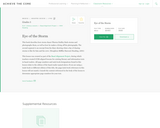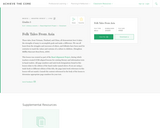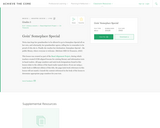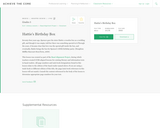
In this lesson, students use comprehension skills to discuss and respond to questions about a text.
- Subject:
- English Language Arts
- Material Type:
- Lesson Plan
- Provider:
- Achieve the Core
- Author:
- Achieve the Core
- Date Added:
- 04/23/2019

In this lesson, students use comprehension skills to discuss and respond to questions about a text.

In this lesson, students use comprehension skills to discuss and respond to questions about a text.

Sometimes students get stuck in thinking every sentence written after the main idea is a supporting key detail. This lesson will look at the difference between an interesting detail and an important detail. *This lesson is the 4th lesson of an 8 lesson unit on non-fiction texts as well as Haiti. It can not stand alone and needs to be completed with the unit. This lesson was developed by Kate Quigley as part of their completion of the North Carolina Global Educator Digital Badge program. This lesson plan has been vetted at the local and state level for standards alignment, Global Education focus, and content accuracy.

Students will be focused on finding the main idea and supporting details of non-fiction articles all while investigating the disaster in Haiti to deepen their knowledge of the topic. *This lesson is the 3rd lesson out of an 8 lesson unit on non-fiction and Haiti. Where this one lesson, could be taught in isolation, it is highly suggested that it be completed within the entire unit in order for students to grasp the full content. This lesson was developed by Kate Quigley as part of their completion of the North Carolina Global Educator Digital Badge program. This lesson plan has been vetted at the local and state level for standards alignment, Global Education focus, and content accuracy.

Students will listen to the read aloud text Serafina’s Promise by Ann E. Burg. They will respond to group discussion starters as part of listening and speaking goals in fifth grade. *This is the 2nd (and ongoing) lesson of an 8 unit lesson on non-fiction and Haiti. This lesson could be taught in isolation, but is highly suggested to be completed within the unit in order for students to fully grasp the content. This lesson was developed by Kate Quigley as part of their completion of the North Carolina Global Educator Digital Badge program. This lesson plan has been vetted at the local and state level for standards alignment, Global Education focus, and content accuracy.

Students will use what they know about main idea and important details to write a summary of an article about Haiti. *This lesson is the 5th lesson of an 8 lesson unit on non-fiction and Haiti. It needs to be completed as part of the unit in order to make sense. This lesson was developed by Kate Quigley as part of their completion of the North Carolina Global Educator Digital Badge program. This lesson plan has been vetted at the local and state level for standards alignment, Global Education focus, and content accuracy.

This article describes the history of the Germans’ favorite sport: soccer. It dates back to China 2,000 years ago and underwent several alterations until the current rules were invented 150 years ago in England. The text closes with the manufacturing process of soccer balls are manufactured and quality improvements over time. The article was written for native speakers 8 years and up.

This article starts by explaining that air actually has weight, because it consists of minute particles that are distributed unevenly - especially based on different altitudes. Then the reader learns that changes in air pressure can be felt in the eardrum. As an extension, the article provides the instructions for an experiment with an air filled toothpaste tube that is taken on a mountain top.

This article provides information about the adaptation of cacti to drought and protection, as well as basic facts about age, distribution, and varieties. Pictures support the text that is written for native speakers age 8 and up.

This scientific article discusses several aspects of blood. It explains how to calculate the typical amount of blood by bodyweight, the channel system of veins and arteries, medical conclusions from blood exams, the reasons for bleeding nose and black spots. In the last part, the different components of blood are explained, such as red and white blood cells. Links to additional pages provide more detailed information on some of the sections. The text is written in child-friendly language for native speakers age 8 and up.

This scientific article explains the features and functions of the human brain. It explains the physical features of the brain and how it is connected to the rest of the nervous system. More information regarding its vegetative functions, the processing speed, and moods provide further information. The text is written for native speakers 9 years and up.

This article describes why the eyes, nose, mouth, and ears are located where they are. The first focuses on the paired organs for spatial perception. Further links lead to articles that elaborate on the topics, first perceived sounds as a baby, uncomfortable noises, and water in the ear. The last part describes the phenomenon that we are breathing through two nostrils. The text is written in child-friendly language for children 10 and up.

This scientific article highlights a multitude of aspects about the tropical rainforest: global location, ethymology, fauna and flora, famous jungle researchers like Jane Goodall, consequences and reasons for jungle destruction, and suggestions that everybody can do to prevent jungle destruction. A link provides more information about the life and work of Jane Goodall. The text is written in child-friendly language and appropriate for readers age 8 and up.

In this lesson, students use comprehension skills to discuss and respond to questions about a text.

Based on the Guided Comprehension Model developed by Maureen McLaughlin and Mary Beth Allen, this lesson introduces students to the comprehension strategy of monitoring.

In this lesson, students use comprehension skills to discuss and respond to questions about a text.

The houses that Native American tribes constructed hundreds of years ago looked a lot different than the houses we’re familiar with today. In this informational text, Sarah J. Bell describes the different houses that Native Americans built. As studentsread, they take notes on how the environment affected the type of house Native Americans built.

In this informational text, Rachel Slivnick discusses the types of stories that Pixar tells. As students read, they take notes on what all Pixar films have in common.

Mohandas Gandhi (1869-1948), also known as Mahatmas Gandhi, was an Indian activist and leader in the Indian independence movement against the British rule in India. In this informational text, Sara Wilson Etienne discusses Gandhi’s march to the sea to protest a law put in place by the British Empire. As students read, they take notes on how Gandhi peacefully protested against the British Empire.

This Project GLAD unit will address human body systems and their interactions. It is an integrated science and ELA unit for 5th grade. Students will know major body systems, their parts, and how those systems work together in the human body.